A textile covering designed to safeguard a king-sized bed from liquids, allergens, and general wear, often incorporating materials or technologies intended to regulate temperature and enhance sleep comfort. These products aim to provide a barrier against spills and stains while mitigating heat retention during sleep. For example, a woven protector made with breathable fibers and a moisture-wicking membrane prevents liquid penetration and promotes air circulation.
The utilization of such protective layers can significantly extend the lifespan of a substantial bed investment. Beyond physical protection, many individuals find that temperature regulation features can lead to improved sleep quality by minimizing night sweats and creating a more consistent thermal environment. Historically, mattress protectors served primarily a hygienic function; however, modern iterations increasingly focus on enhancing sleep comfort and providing additional benefits, such as allergen control.
The following sections will delve into the specific materials employed in these products, explore the different cooling technologies available, discuss the optimal selection criteria, and provide guidance on the proper care and maintenance to ensure longevity and continued performance.
Guidance for Selecting a Cooling King Mattress Protector
This section provides essential guidance for selecting a protective layer designed for a king-sized bed that offers enhanced temperature regulation for optimal sleep. Consider the following recommendations when making a purchase:
Tip 1: Material Composition Assessment: Examine the fabric composition closely. Natural fibers like Tencel or bamboo rayon offer superior breathability and moisture-wicking properties compared to synthetic options such as polyester. Prioritize protectors with a high percentage of natural or specialized cooling fibers.
Tip 2: Evaluate Cooling Technology: Investigate the incorporated cooling technologies. Phase change materials (PCMs) absorb and release heat to maintain a consistent temperature. Consider protectors with PCM infusions or other advanced cooling features to mitigate heat retention effectively.
Tip 3: Prioritize Breathability: Opt for protectors featuring a breathable membrane or construction. This allows for adequate airflow, preventing the buildup of heat and moisture beneath the protector. Look for protectors specifically designed to promote ventilation.
Tip 4: Consider Waterproofing Level: Determine the necessary level of waterproofing. While complete waterproofing is beneficial for spill protection, it can sometimes compromise breathability. Assess the trade-off between protection and airflow based on individual needs and circumstances.
Tip 5: Check for Allergen Resistance: Evaluate the protector’s allergen resistance. A tightly woven fabric can prevent dust mites and other allergens from penetrating the mattress. Look for protectors specifically labeled as hypoallergenic or allergen-resistant.
Tip 6: Review Washing Instructions: Ascertain the ease of care. Select a protector that is machine washable and dryer-safe for convenient maintenance. Follow the manufacturer’s instructions to preserve the protector’s integrity and performance.
Tip 7: Read Customer Reviews: Consult customer reviews for insights into real-world performance. Pay attention to comments regarding cooling effectiveness, durability, and overall satisfaction. This can provide valuable information beyond the manufacturer’s specifications.
Following these guidelines ensures the selection of a mattress protector that effectively safeguards a king-sized bed while simultaneously promoting a cooler, more comfortable sleep environment.
The subsequent sections will explore specific product examples and provide further details on installation and long-term care.
1. Material breathability
Material breathability directly influences the cooling effectiveness of a king-sized mattress protector. Breathability refers to a fabric’s ability to permit air and moisture vapor to pass through its structure. When a mattress protector lacks sufficient breathability, it traps heat and humidity against the sleeper’s body, creating a warm, uncomfortable sleep environment. This negates the intended cooling effect and can lead to increased night sweats and disrupted sleep. A practical example is a protector made of tightly woven polyester, which often lacks breathability, causing heat retention. Conversely, protectors constructed from materials like Tencel or bamboo rayon, known for their open weave structures, promote airflow and facilitate the evaporation of moisture, thereby contributing to a cooler sleep surface.
The effectiveness of the cooling mechanisms in a mattress protector, such as phase change materials or cooling gels, is also contingent on the breathability of the surrounding fabric. If the outer layers restrict airflow, the cooling technology’s ability to dissipate heat is severely hampered. For example, a protector with embedded cooling gel covered by a non-breathable waterproof layer will not effectively regulate temperature, as the heat cannot escape. The selection of breathable materials is, therefore, an integral component in achieving the intended cooling performance. Beyond the fabric itself, the construction of the protector, including features like ventilated side panels or quilted patterns designed to enhance airflow, can further contribute to breathability.
In summary, material breathability is a foundational element in determining the cooling capability of a king-sized mattress protector. Choosing protectors crafted from breathable fabrics, like natural fibers or specialized cooling textiles, and with design elements that promote airflow ensures optimal temperature regulation and a more comfortable sleep experience. The absence of breathability effectively nullifies any other cooling technologies incorporated within the product. This understanding is significant as it guides consumers toward selecting protectors that genuinely deliver on their promise of enhanced cooling.
2. Waterproof membrane
The integration of a waterproof membrane in a king-sized mattress protector introduces a complexity when aiming for a cooling effect. While crucial for protection against liquids and spills, the properties of common waterproof materials can inherently impede breathability and, consequently, undermine cooling performance.
- Material Composition and Breathability Trade-off
Waterproof membranes are typically constructed from materials like polyurethane or thermoplastic polyurethane (TPU). These materials, while effective barriers against liquids, often possess limited air permeability. The trade-off lies in achieving a balance between complete waterproof protection and sufficient airflow to facilitate cooling. Lower-quality or thicker membranes exacerbate this issue, creating a vapor barrier that traps heat and moisture.
- Impact on Cooling Technologies
The presence of a waterproof membrane can directly affect the efficiency of other cooling technologies incorporated into the mattress protector. For instance, if the protector utilizes phase change materials (PCMs) to absorb heat, the waterproof membrane can hinder the dissipation of that absorbed heat, reducing the overall cooling effect. A non-breathable membrane effectively insulates the mattress, preventing the PCM from functioning optimally.
- Membrane Construction and Ventilation
Certain manufacturing techniques attempt to mitigate the breathability limitations of waterproof membranes. Micro-porous membranes, for example, feature tiny pores that allow air and moisture vapor to pass through while still blocking liquids. Laminated or quilted constructions can also promote some degree of airflow by creating air pockets between the membrane and the sleeping surface. However, the degree of ventilation achieved varies significantly depending on the specific design and materials used.
- Long-Term Performance Considerations
The waterproof membrane’s integrity and performance over time are relevant to the cooling effectiveness. Repeated washing or exposure to body oils can degrade the membrane, potentially compromising its waterproof properties and, indirectly, its ability to maintain a hygienic and comfortable sleep surface. Deterioration can lead to localized areas of reduced breathability or even complete barrier failure, impacting overall sleep quality.
Effectively integrating a waterproof membrane into a king-sized mattress protector designed for cooling requires careful consideration of material selection, construction techniques, and long-term performance. While waterproof protection is essential, minimizing its negative impact on breathability is critical to achieving the desired cooling effect. Consumers must evaluate the specific features and technologies employed to determine whether a protector effectively balances waterproof functionality with temperature regulation capabilities.
3. Hypoallergenic barrier
The presence of a hypoallergenic barrier within a king-sized mattress protector directly influences its effectiveness in promoting a healthy sleep environment. This barrier, typically achieved through tightly woven fabrics or specialized membrane technology, prevents dust mites, pet dander, and other allergens from penetrating the mattress core. The primary consequence of allergen penetration is the potential for respiratory irritation, allergic reactions, and diminished sleep quality. Thus, a robust hypoallergenic barrier is not merely a supplementary feature, but a functional necessity. Consider an individual with dust mite allergies: without this barrier, the mattress becomes a reservoir for allergens, exacerbating symptoms such as sneezing, congestion, and skin irritation. The integration of a hypoallergenic barrier mitigates these issues, creating a cleaner sleep surface and reducing exposure to potential irritants. This is significant because it directly impacts the physiological well-being of the individual.
Furthermore, the relationship between a hypoallergenic barrier and a cooling king mattress protector is symbiotic. While the barrier prevents allergen accumulation, materials promoting cooling often exhibit increased breathability. This enhanced airflow, while beneficial for temperature regulation, can inadvertently create pathways for allergen migration if the fabric weave is not sufficiently tight or if a dedicated barrier membrane is absent. Therefore, the most effective cooling king mattress protectors incorporate a tightly woven fabric or membrane specifically designed to block allergens, ensuring that the enhanced breathability does not compromise hypoallergenic properties. An example of this is a protector utilizing a micro-porous membrane; the membrane allows air to pass, aiding in cooling, while simultaneously preventing allergens from entering the mattress.
In summation, the hypoallergenic barrier is an indispensable component of a cooling king mattress protector, ensuring a cleaner and healthier sleep environment. Balancing breathability for cooling with a robust allergen barrier requires careful material selection and construction techniques. The practical significance of this understanding lies in the consumer’s ability to prioritize products that demonstrably address both temperature regulation and allergen protection, thereby promoting overall sleep health and well-being. The challenge remains in identifying protectors that achieve this balance effectively, relying on verifiable certifications and detailed product specifications.
4. Temperature regulation
Temperature regulation is an indispensable attribute of effective cooling king mattress protectors. The primary function of these protectors extends beyond mere physical safeguarding; they must actively contribute to maintaining a comfortable sleep temperature. Elevated skin temperature during sleep can lead to restlessness, disrupted sleep cycles, and increased susceptibility to night sweats. Therefore, the cooling properties are directly correlated to the protector’s ability to regulate the sleeping surface’s temperature. This is achieved through various mechanisms, including the use of breathable materials that facilitate airflow and the incorporation of phase change materials (PCMs) that absorb and release heat. A protector that fails to regulate temperature effectively negates its purpose as a “cooling” product, essentially offering only basic mattress protection without thermal benefit. For instance, a king mattress protector made from non-breathable synthetic materials, regardless of its waterproof qualities, will impede heat dissipation, leading to a warmer sleep environment. This contrasts sharply with protectors incorporating Tencel fibers and PCM technology, which actively work to maintain a consistent and cooler surface temperature.
The efficacy of temperature regulation in a king mattress protector depends on a combination of material properties and construction design. Breathable fabrics, such as bamboo rayon or cotton, allow for continuous airflow, dissipating heat and moisture. Simultaneously, PCMs embedded within the protector absorb excess body heat, preventing temperature spikes. Effective designs often incorporate ventilation channels or quilted patterns that further enhance airflow. However, the presence of a waterproof membrane can significantly impede temperature regulation if it lacks breathability. High-quality cooling king mattress protectors utilize micro-porous waterproof membranes that allow for air and moisture vapor transfer while maintaining liquid protection. Furthermore, the protector’s thickness and fit also impact temperature regulation. An overly thick protector can reduce airflow, while a loose fit can create air pockets that disrupt temperature consistency. The selection of materials with low thermal resistance is also essential, minimizing heat retention and promoting effective heat dissipation.
In conclusion, temperature regulation is not simply an optional add-on, but the defining characteristic of a cooling king mattress protector. The combination of breathable materials, advanced cooling technologies, and thoughtful design elements directly impacts the protector’s ability to maintain a comfortable sleep environment. The practical implication is that consumers must carefully evaluate product specifications and material compositions, prioritizing protectors that demonstrably facilitate heat dissipation and moisture management. Ultimately, the value of a cooling king mattress protector lies in its capacity to effectively regulate temperature, improving sleep quality and promoting overall well-being. Without this functionality, the protector functions as a basic barrier, failing to deliver the intended benefits of a cooling product.
5. Size compatibility
The accurate sizing of a king mattress protector is paramount, especially when integrated with cooling technology. Deviations from the precise dimensions of a standard king-sized mattress can compromise both the protective function and the thermal regulation properties of the product.
- Impact on Airflow and Cooling Efficiency
An ill-fitting protector, either too loose or too tight, can disrupt the intended airflow around the mattress. A protector that is too loose may create air pockets, leading to uneven temperature distribution and diminishing the effectiveness of integrated cooling technologies. Conversely, an overly tight protector can compress the mattress materials, impeding breathability and negating any cooling benefits. Real-world examples include protectors that bunch up or shift during sleep, creating warm spots and hindering the intended cooling mechanism. This is particularly detrimental with protectors employing phase-change materials (PCMs), which require consistent contact with the sleeping surface to effectively regulate temperature.
- Effects on Waterproofing and Protection
Incorrect sizing can compromise the waterproof capabilities of the protector. A protector that is too small may not adequately cover the entire mattress surface, leaving vulnerable areas exposed to spills and stains. A protector that is too large might bunch up and create weak points in the waterproof membrane, increasing the risk of liquid penetration. The implications are significant, as compromised waterproofing can lead to mattress damage, allergen accumulation, and the need for premature replacement. For example, a protector that does not properly fit around the mattress edges may allow liquid to seep into the mattress core, creating a breeding ground for mold and bacteria.
- Influence on Mattress Longevity and Warranty
Improper fit can accelerate wear and tear on the mattress itself. A protector that constantly shifts or rubs against the mattress surface can cause friction, leading to premature degradation of the mattress fibers and support structure. Furthermore, using a protector that does not conform to the mattress manufacturer’s specifications can potentially void the mattress warranty. The consequence is a shortened lifespan for the mattress and the potential for costly replacements. Consider the case of a mattress warranty that explicitly requires the use of a correctly sized protector to maintain coverage against defects; using an improperly sized protector could invalidate this warranty.
- Compatibility with Bedding Accessories
Size compatibility also extends to the interaction between the mattress protector and other bedding accessories, such as fitted sheets and mattress toppers. An improperly sized protector can interfere with the fit and function of these accessories, leading to discomfort and reduced sleep quality. For instance, a protector that is too thick or bulky may make it difficult to securely fit a standard-sized fitted sheet, resulting in slippage and increased movement during sleep. This can disrupt the cooling effect by altering the intended airflow and creating uneven pressure points.
In essence, precise size compatibility is integral to the overall performance and longevity of both the king mattress protector and the underlying mattress. By ensuring an accurate fit, consumers can maximize the cooling benefits, maintain effective protection, and preserve the integrity of their sleep environment.
6. Durability
The durability of a cooling king mattress protector is intrinsically linked to its long-term effectiveness in regulating sleep temperature. The ability of a mattress protector to consistently perform its cooling function is directly dependent on its resistance to degradation from repeated use, washing, and exposure to body fluids. Compromised structural integrity can lead to diminished breathability, reduced effectiveness of cooling technologies like phase change materials (PCMs), and increased susceptibility to allergen penetration. For example, a protector with seams that weaken and tear over time may develop areas where the cooling layer is no longer evenly distributed, resulting in inconsistent temperature regulation across the mattress surface. Similarly, a waterproof membrane that delaminates or cracks can impede airflow, negating any inherent cooling properties. The practical significance of this understanding lies in the consumer’s ability to make informed purchasing decisions, prioritizing protectors constructed from high-quality materials and featuring robust construction techniques.
The selection of durable materials and manufacturing processes is critical for ensuring the continued performance of cooling features. For instance, protectors made with tightly woven, high-thread-count fabrics are generally more resistant to wear and tear than those made with loosely woven materials. Reinforcing seams, utilizing durable zippers, and incorporating abrasion-resistant surface treatments can further extend the protector’s lifespan. The choice of waterproof membrane also plays a significant role. Membranes made from thermoplastic polyurethane (TPU) tend to be more flexible and resistant to cracking than those made from traditional polyurethane (PU), enhancing long-term waterproof protection without compromising breathability significantly. Furthermore, following proper care instructions, such as using mild detergents and avoiding excessive heat during washing and drying, can mitigate wear and tear and prolong the protector’s effectiveness.
In summary, the durability of a cooling king mattress protector is not merely a matter of longevity, but an essential component of its ongoing ability to deliver the promised cooling benefits. Material selection, construction quality, and adherence to proper care guidelines collectively determine the protector’s lifespan and sustained performance. The practical implications of prioritizing durability are reduced replacement frequency, consistent sleep temperature regulation, and a healthier sleep environment free from allergens and moisture buildup. The challenge remains in objectively assessing durability claims, requiring consumers to rely on product specifications, warranty information, and independent reviews to make informed decisions.
7. Ease of cleaning
The characteristic of ease of cleaning significantly impacts the sustained performance and hygiene of a cooling king mattress protector. The frequency with which these protectors require laundering, coupled with the ease of the cleaning process itself, directly influences their longevity, effectiveness in allergen control, and maintenance of intended cooling properties.
- Material Compatibility with Washing Protocols
The fabric composition of a king mattress protector must withstand repeated washing cycles without significant degradation. Materials such as cotton blends and certain synthetic fibers are more resilient to laundering than delicate fabrics. Protectors that cannot be machine washed or require specialized cleaning procedures present a practical disadvantage, as frequent handwashing or dry cleaning is often unsustainable for most users. A protector that shrinks, loses its shape, or experiences seam damage after washing compromises its fit and protective function.
- Waterproof Membrane Integrity
Many cooling king mattress protectors incorporate a waterproof membrane to safeguard against spills and stains. The washing process can potentially damage this membrane, leading to reduced waterproof effectiveness. Protectors with membranes that crack, peel, or delaminate after repeated washings no longer provide adequate protection against liquid penetration. The ability of the membrane to retain its integrity under standard washing conditions is, therefore, a critical determinant of its durability and long-term performance.
- Stain Resistance and Removal
Even with a waterproof membrane, surface stains from spills, sweat, or other bodily fluids may occur. The ease with which these stains can be removed is crucial for maintaining the cleanliness and hygiene of the protector. Protectors treated with stain-resistant finishes can simplify the cleaning process and reduce the likelihood of permanent discoloration. The effectiveness of stain removal agents on the protector’s fabric is a key factor in preserving its appearance and preventing the buildup of allergens and bacteria.
- Drying Requirements and Time
The drying process following washing can also impact the long-term performance of a cooling king mattress protector. High heat settings can damage certain fabrics and waterproof membranes, potentially reducing their breathability and waterproof effectiveness. Protectors that require extended air drying or cannot be tumble dried present a practical challenge for many users. The ability of the protector to dry quickly and efficiently without compromising its material properties is an important consideration.
The combination of these factors determines the practical feasibility of maintaining a cooling king mattress protector in a clean and hygienic condition. The ease of cleaning, encompassing washing, stain removal, and drying, directly influences the protector’s longevity, performance, and contribution to a healthy sleep environment. Selecting a protector that balances effective cooling and protection with ease of care is essential for long-term user satisfaction.
Frequently Asked Questions
This section addresses common inquiries regarding the functionality, benefits, and proper utilization of mattress protectors designed to regulate temperature on king-sized beds. The information provided aims to clarify misconceptions and provide practical guidance.
Question 1: How does a cooling king mattress protector differ from a standard mattress protector?
Cooling mattress protectors incorporate specific materials and technologies aimed at dissipating heat and enhancing airflow. Standard protectors primarily focus on safeguarding the mattress from spills and allergens without necessarily addressing temperature regulation.
Question 2: What materials are commonly used in cooling king mattress protectors?
Typical materials include breathable fabrics like Tencel, bamboo rayon, and specialized synthetic blends designed for moisture-wicking and airflow. Phase change materials (PCMs) are also frequently integrated to absorb and release heat.
Question 3: Will a cooling king mattress protector completely eliminate night sweats?
While these protectors can significantly reduce heat retention and improve sleep comfort, their effectiveness in completely eliminating night sweats depends on the underlying cause of the condition and individual physiological factors. They are not a substitute for medical treatment.
Question 4: Can a cooling king mattress protector be used with a heated mattress pad?
The use of a heated mattress pad may counteract the cooling properties of the protector. The combined effect could potentially lead to inconsistent temperature regulation and reduced overall comfort. It is generally recommended to avoid using both simultaneously.
Question 5: How often should a cooling king mattress protector be washed?
Washing frequency depends on usage and individual hygiene preferences. However, it is generally recommended to launder the protector every 1-2 months, or more frequently if spills or stains occur. Always follow the manufacturer’s care instructions.
Question 6: Do all cooling king mattress protectors provide adequate waterproof protection?
Not all protectors marketed as “cooling” offer comprehensive waterproof protection. The level of waterproofing varies depending on the specific materials and construction used. Consumers should verify the protector’s waterproof capabilities before purchase, considering the balance between cooling and protection.
In summary, selecting a mattress protector engineered for both cooling and protection necessitates a careful evaluation of materials, technologies, and care requirements. Understanding these factors enables informed decision-making.
The subsequent section provides detailed information on installation and maintenance to maximize the lifespan and effectiveness of the chosen product.
Conclusion
The preceding analysis has thoroughly explored the multifaceted aspects of king mattress protector cooling. Key points elucidated encompass material selection, cooling technologies, hypoallergenic properties, the critical role of size compatibility, and the practical considerations of durability and ease of cleaning. The effectiveness of such a protector is not merely a function of individual features but a synergistic interaction of these elements.
Ultimately, the informed selection and proper maintenance of a king mattress protector cooling are investments in sleep hygiene and long-term well-being. Continued advancements in textile technology promise future innovations in this product category, offering enhanced temperature regulation and improved sleep quality. Consumers are encouraged to carefully consider their individual needs and prioritize protectors that demonstrably balance performance, protection, and durability.


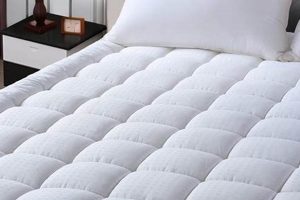
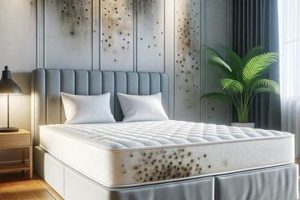
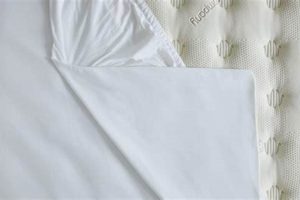
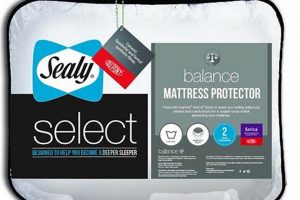
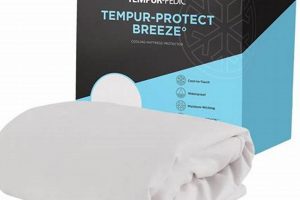
![Best Malouf Mattress Protector [Guide & Review] Organic & Natural Mattress Buyer’s Guide: Non-Toxic Sleep Solutions Best Malouf Mattress Protector [Guide & Review] | Organic & Natural Mattress Buyer’s Guide: Non-Toxic Sleep Solutions](https://mattressworldpa.com/wp-content/uploads/2025/07/th-2531-300x200.jpg)